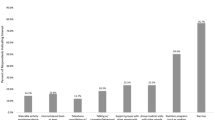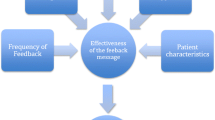Abstract
Purpose and Background
The relationship between risk perceptions and diabetes self-care remains ambiguous. This study aimed to assess baseline, 1-year follow-up, and change score relationships among perceived risk, diabetes self-care, and glycemic control for adult individuals participating in a behavioral intervention that improved glycemic control relative to the active control.
Method
One-year randomized trial compared a behavioral telephonic intervention with a print only intervention. Participants (N = 526) are members of a union/employer sponsored health benefit plan, with HbA1c ≥ 7.5 %, prescribed at least one oral diabetes medication. Participants rated perceived risk of diabetes and its complications and diabetes self-care at baseline and 1 year. Data were collected in a large urban area in the USA.
Results
There were no relationships between risk perceptions and glycemic control during the study. Baseline perceived risk predicted follow-up self-care. Additionally, participants assigned to the intervention group showed significant changes in dietary and exercise adherence at high levels of risk knowledge and low levels of optimistic bias.
Conclusion
Perceived risk relates to dietary, exercise, and medication adherence in diabetes. The perceived risk construct might foster a more coherent conceptualization of the relationship between one’s diabetes, possible complications, and diabetes self-care behaviors.


Similar content being viewed by others
References
Edwards W. The theory of decision making. Psychol Bull. 1954;51:380–417.
Maddux JE, Rogers RW. Protection motivation and self-efficacy: a revised theory of fear appeals and attitude change. J Exp Soc Psychol. 1983;19(5):469–79.
Rosenstock IM. The health belief model: origins and correlates. Health Educ Monogr. 1974;2:336–53.
Brewer NT, Weinstein ND, Cuite CL, Herrington JE. Risk perceptions and their relation to risk behavior. Ann Behav Med. 2004;27(2):125–30.
Janz NK, Becker MH. The health belief model: a decade later (Review). Health Educ Q. 1984;11:1–47.
Gerrard M, Gibbons FX, Bushman BJ. Relation between perceived vulnerability to HIV and precautionary sexual behavior. Psychol Bull. 1996;119:390–409.
Weinstein ND. Testing four competing theories of health-protective behavior. Health Psychol. 1993;12:324–33.
Lewis KS, Bradley C. Measures of diabetes-specific health beliefs. In: Bradley C, editor. Handbook of psychology and diabetes. Chur: Harwood Academic; 1994. p. 247–89.
van der Plight J. Perceived risk and vulnerability as predictors of precautionary behavior. Br J Health Psychol. 1998;2:1–14.
World Health Organization. (2011). Diabetes fact sheet. http://www.who.int/mediacentre/factsheets/fs312/en/index.html. Accessed 30 May 2012.
Fowler MJ. Diabetes treatment, part 1: diet and exercise. Clin Diabetes. 2007;25(3):105–8.
Fowler MJ. Diabetes treatment, part 2: oral agents for glycemic management. Clin Diabetes. 2007;25(4):131–4.
Cheung BY, Ong KL, Cherny SS, Sham PC, Tso AK, Lam KL. Diabetes prevalence and therapeutic target achievement in the United States, 1999 to 2006. Am J Med. 2009;122:443–53.
Amos A, McCarty D, Zimmet P. The rising global burden of diabetes and its complications: estimates and projections to the year 2010. Diabetic Med. 1997;14:S1–S85.
de Courten M, Bennett PH, Tuomilehto J, Zimmet P. In: Alberti KG, Zimmet P, DeFronzo RA, Keen H, editors. International textbook of diabetes mellitus. Chichester: Wiley; 1997. p. 143–70.
O’Dea K. Westernisation, insulin resistance and diabetes in Australian Aborigines. Med J Aust. 1991;155:258–64.
Ramachandran A, Snehalatha C, Latha E, Vijay V, Viswanathan M. Rising prevalence of NIDDM in an urban population in India. Diabetologia. 1997;40:232–7.
Center for Disease Control and Prevention. National diabetes fact sheet: general information and national estimates of diabetes in the U.S. Atlanta: U.S. Department of Health and Human Services, Centers for Disease Control and Prevention; 2005.
Lanting LC, Joung IM, Mackenbach JP, Lamberts SW, Bootsma AH. Ethnic differences in mortality, end-stage complications, and quality of care among diabetic patients: a review. Diabetes Care. 2005;28(9):2280–8.
Mauldon M, Melkus GD, Cagganello M. Tomando control: a culturally appropriate diabetes education program for Spanish-speaking individuals with type 2 diabetes mellitus—evaluation of a pilot project. Diabetes Educ. 2006;32(5):751–60.
McBean AM, Li S, Gilbertson DT, Collins AJ. Differences in diabetes prevalence, incidence, and mortality among the elderly of four racial/ethnic groups: Whites, Blacks, Hispanics, and Asians. Diabetes Care. 2004;27(10):2317–24.
Centers for Disease Control and Prevention. National diabetes fact sheet: national estimates and general information on diabetes and prediabetes in the United States, 2011. Atlanta: U.S. Department of Health and Human Services, Centers for Disease Control and Prevention; 2011.
Venkataraman R, Nanda NC, Baweja G, Parikh N, Bhatia V. Prevalence of diabetes mellitus and related conditions in Asian Indians living in the United States. Am J Cardiol. 2004;94(7):977–80.
Anderson D, Christison-Lagay J. Diabetes self-management in a community health center: improving health behaviors and clinical outcomes for underserved patients. Clin Diabets. 2008;26(1):22–7.
Bell RA, Arcury TA, Stafford JM, Golden SL, Snively BM, Quandt SA. Ethnic and sex differences in ownership of preventive health equipment among rural older adults with diabetes. J Rural Health. 2007;23(4):332–8.
Coronado GD, Thompson B, Tejeda S, Godina R, Chen L. Sociodemographic factors and self-management practices related to type 2 diabetes among Hispanics and Non-Hispanic Whites in a rural setting. J Rural Health. 2007;23(1):49–54.
Mann DM, Ponieman D, Leventhal H, Halm EA. Misconceptions about diabetes and its management among low-income minorities with diabetes. Diabetes Care. 2009;32(4):591–3.
Rhee MK, Cook CB, El-Kebbi I, et al. Barriers to diabetes education in urban patients: perceptions, patterns, and associated factors. Diabetes Educ. 2005;31(3):410–7.
Patino AM, Sanchez J, Eidson M, Delamater AM. Health beliefs and regimen adherence in minority adolescents with type 1 diabetes. J Pediatric Psychol. 2005;30(6):503–12.
Walker EA, Mertz CK, Kalten MR, Flynn J. Risk perception for developing diabetes: comparative risk judgments of physicians. Diabetes Care. 2003;26:2543–8.
Weinstein ND, Rothman AJ, Nicolich M. Use of correlational data to examine the effects of risk perception on precautionary behaviors. Psychol Health. 1998;13:479–501.
Cohen HW, Shmukler C, Ullman R, Rivera CM, Walker EA. Education and psychological aspects measurements of medication adherence in diabetic patients with poorly controlled HbA1c. Diabetic Med. 2010;27:210–6.
Walker EA, Shmukler C, Ullman R, Scollan-Koliopolous M, Blanco E, Cohen H. Results of a successful telephonic intervention to improve diabetes control in urban adults. Diabetes Care. 2011;34(1):2–7.
Jeppsson JO, Jerntorp P, Almer LO, Persson R, Ekberg G, Sundkvist G. Capillary blood on filter paper for determination of HbA1c by ion exchange chromatography. Diabetes Care. 1996;19:142–5.
Toobert DJ, Hampson SE, Glasgow RE. The summary of diabetes self-care activities measure: results from 7 studies and a revised scale. Diabetes Care. 2000;23(7):943–50.
Walker EA, Caban A, Schechter CB, et al. Measuring comparative risk perceptions in an urban minority population: the risk perception survey for diabetes. Diabetes Educ. 2007;33(1):103–10.
Weinger K, Butler HA, Welch GW, La Greca AM. Measuring diabetes self-care: a psychometric analysis of the self-care inventory-revised with adults. Diabetes Care. 2005;28:1346–52.
Nunnally JC, Bernstein IH. Psychometric theory. New York: McGraw-Hill; 1994.
Aiken LS, West SG. Multiple regression: testing and interpreting interactions. Newbury Park: Sage; 1991.
Clark DO. Physical activity and its correlates among urban primary care patients aged 55 years or older. J Gerontol Soc Sci. 1999;54B(1):S41–8.
Wilcox S, Bopp M, Oberrecht L, Kammermann SK, McElmurray CT. Psychosocial and perceived environmental correlates of physical activity in rural and older African American and White Women. J Gerontol Psych Sci. 2003;58(6):P329–37.
Skelly AH, Leeman J, Carlson J, Soward A, Burns D. Conceptual model of symptom-focused diabetes care for African Americans. J Nurs Scholar. 2008;40:261–7.
Sousa VD, Zauszniewski JA, Musil CM, Price Lea PJ, Davis SA. Relationships among self-care agency, self-efficacy, self-care, and glycemic control. Res Theor Nurs Pract. 2005;19:217–30.
Heshka JT, Palleschi C, Howley H, Wilson B, Wells PS. A systematic review of perceived risks, psychological and behavioral impacts of genetic testing. Genet Med. 2008;10(1):19–32.
Kash KM, Holland JC, Halper MS, Miller JD. Psychological distress and surveillance behaviors of women with a family history of breast cancer. J Natl Cancer Inst. 1992;84:24–30.
Lerman C, Schwarz M. Adherence and psychological adjustment among women at high risk for breast cancer. Breast Cancer Res Treat. 1993;28:145–55.
McCaul KD, Branstetter AD, Schroeder DM, Glasgow RE. What is the relationship between breast cancer risk and mammography screening? A meta-analytic review. Health Psychol. 1996;15(6):423–9.
Metcalf KA, Narod SA. Breast cancer risk perception among women who have undergone prophylactic bilateral mastectomy. J Natl Cancer Inst. 2002;94:1564–9.
Vaeth PA, Willett C, DuWayne L. Illness risk perceptions and trust: the association with blood pressure self-measurement. Am J Health Behav. 2011;35(1):105–17.
Fumaz CR, Muñoz-Moreno JA, Moltó J, Ferrer MJ, López-Blázquez R, Negredo E, et al. Sustained antirretroviral treatment adherence in survivors of the pre-HAART era: attitudes and beliefs. AIDS Care. 2008;20(7):796–805.
Gao X, Nau DP, Rosenbluth SA, Scott V, Woodward C. The relationship of disease severity, health beliefs and medication adherence among HIV patients. AIDS Care: Psychol Socio-med Asp AIDS/HIV. 2000;12(4):387–98.
Gonzalez JS, Schneider H. Methodological issues in the assessment of diabetes treatment adherence. Curr Diab Rep. 2011;11:472–9.
Lu M, Safren SA, Skolnik PR, Rogers WH, Coady W, Hardy H, et al. Optimal recall period and response task for self-reported HIV medication adherence. AIDS Behav. 2008;12:86–94.
Gonzalez JS, Schneider H, Wexler DJ, Psaros C, Delahanty LM, Cagliero E, et al. The validity of medication adherence self-reports in adults with type 2 diabetes. Diab Care. 2012;35:1–7.
Acknowledgments
This study was supported by NIH grants R18 DK62038 and DK020541. Parts of this study were presented in poster form at the 32nd Annual Meeting and Scientific Sessions of the Society of Behavioral Medicine, Washington, DC, USA, 27–30 April 2011. We gratefully acknowledge the data management contributions of Fionnuala King of the 1199SEIU Benefit and Pension Funds; the talented health educators, including Giovanna DiFrancesca, Kathleen McCabe, Gisela Mojica, Jennifer Case, Tara DeWitt, Gabriel Ferreira, Marlene Taveras, Samara Lipsky, Dr. Hollie Jones, and Hector Cariello; data management support from Maria Kalten and Jennifer Lukin, all staff from the Albert Einstein College of Medicine; and especially, the participants in New York City who volunteered for the study.
Conflicts of interest
The authors have no conflicts of interest to disclose. The authors have full control of all primary data, and we agree to allow the journal to review their data if requested.
Author information
Authors and Affiliations
Corresponding author
Rights and permissions
About this article
Cite this article
Shreck, E., Gonzalez, J.S., Cohen, H.W. et al. Risk Perception and Self-Management in Urban, Diverse Adults with Type 2 Diabetes: The Improving Diabetes Outcomes Study. Int.J. Behav. Med. 21, 88–98 (2014). https://doi.org/10.1007/s12529-013-9291-4
Published:
Issue Date:
DOI: https://doi.org/10.1007/s12529-013-9291-4




